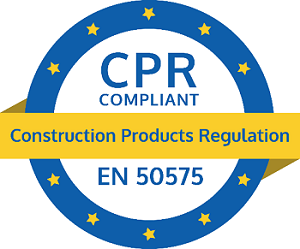CPR - A Not-So-Ridiculous Regulation
December 20, 2017 / General
There’s no doubt that the European Union has a lot of rules and regulations—something frequently pointed out by those who campaigned for a Brexit vote in the United Kingdom. And many joke about some of the more ridiculous ones, like the law that prohibits people from eating pet horses, or the one that prohibits manufacturers of bottled water from labels suggesting that consumption could fight dehydration. (Since when didn’t water fight dehydration?)

Thankfully some of the more ridiculous EU regulations have been repealed, such as the 1995 regulation preventing the sale of bananas and cucumbers with an extreme or unsightly curvature. But there are still plenty of EU regulations in place that affect our cabling industry (think RoHS, REACH and WEEE), and there’s one that cabling manufacturers had to start complying with in July 2017-CPR.
While those of us on this side of the pond tend to think of this acronym as a life-saving procedure, CPR-compliant cables can also save lives. And that’s not at all ridiculous. Let’s take a closer look.
What is CPR?
CPR, which stands for the Construction Products Regulation, is intended to ensure reliable information on construction products in relation to their reaction and resistance to fire, as well as release of dangerous substances during normal operation, dismantling and recycling. The regulation provides this using "common technical language” based on uniform assessment methods, and this language must be used by manufacturers declaring the performance of their cables, as well as by the EU Member States when specifying requirements and by users (i.e., designers and installers) when specifying products for construction projects.
CPR regulations apply to any construction product that is intended to be permanently incorporated into a facility, including cables that provide communications and not specifically designated as temporary. So in our industry, that applies to pretty much every cabling infrastructure installation except for the non-fixed portions such as patch cords and jumpers.
As part of CPR, all copper and fiber cables sold into the EU market must comply and carry the CE mark. Every CPR product also requires a Declaration of Performance (DoP) from the manufacturer that identifies the product, its intended use and its Euroclass characteristics.
What are Euroclasses?
Under CPR, there are seven different Euroclasses that replace the existing IEC 60332 flammability ratings. Outlined in the EN50575 standard for fire requirements of power, control and communications cables, the Euroclasses include A, B1, B2, C, D, E and F, with A as the most flame retardant and F as the least.
The various Euroclasses are determined by each EU member state for their specific construction regulations – typically dependent on building type or space. For example, several countries require Euroclass C for high-rise buildings and B1 or B2 for fire escapes or buildings where evacuation is difficult. In general, hospitals, schools and most public buildings have a higher requirement (typically Euroclass C or D) than what was previously considered the norm (Euroclass E that equates to meeting IEC 6033-1-2).
How Will My Cables Change?
In terms of the construction of the cable, any changes made to adhere to a certain Euroclass are in the jacketing and insulation materials in relation to flame propagation, as a well as smoke production, flaming droplets and acidity.
Changes that may be more noticeable include part numbers, cable print legends, colors and box labeling as many manufacturers are now needing to distinguish between CPR and non-CPR cables. To access the required DoP certificates for cables, some manufacturers are adding QR codes to their packaging that when scanned will link to the full DoP. Others may have a search function on their website to search for DoPs by part number.
The good news is that in terms of transmission performance, CPR-compliant cables are no different than non-CPR cables—the CE mark assures that the product meets a specific fire standard, not a quality or transmission performance standard. In other words, CPR Category 6A/Class EA cable still performs like Category 6A/Class EA cable and CPR OM4 multimode fiber cable still performs like OM4 multimode fiber cable. And that means that your compliance testing for TIA and ISO/IEC performance parameters does not change either.
So while some may consider the EU a tad too “regulation happy,” consider that fact that CPR results in Euroclasses that are common to all construction products across all of Europe, eliminating any confusion and ensuring understanding among all European decision makers and stakeholders. This will go a long way in helping to ensure the safety of people and the protection of property in the event of a fire—something that can’t be at all considered as ridiculous as prohibiting one from eating their pet horse.





